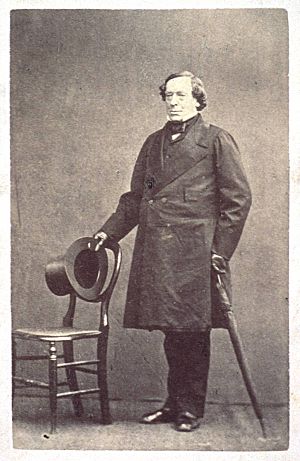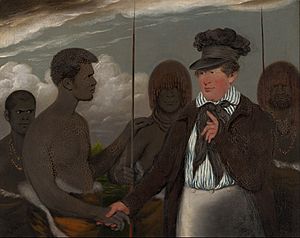George Augustus Robinson facts for kids
George Augustus Robinson (born 1791, died 1866) was a British builder and preacher. He moved to Hobart, Australia, in 1824. He became known for trying to make peace between Aboriginal Tasmanians and British settlers. This was during a time of serious conflict called the Black Wars. Later, in 1839, he became the Chief Protector of Aborigines in the Port Phillip District (now Victoria). He held this important job until 1849.
Contents
Early Life
Robinson was born on March 22, 1791, likely in London, England. His father, William Robinson, was a builder. George followed his father into the building business.
In 1814, he married Maria Amelia Evans. They had five children together. In 1824, Robinson decided to move to Australia. He sailed to Hobart Town in Van Diemen's Land (now Tasmania). He arrived in January 1824 and started working as a builder. His wife and children joined him in April 1826.
Time in Van Diemen's Land (Tasmania)
During the 1820s, there were many conflicts between settlers and Aboriginal Tasmanians. This period is known as the Black War. In 1830, Robinson looked into a terrible event called the Cape Grim massacre from 1828. He reported that 30 Aboriginal people had been killed.
Robinson was asked to help bring peace between the settlers and Aboriginal people. His main goal was to gather the Aboriginal people. He planned to move them to a new camp called Wybalenna on Flinders Island.
Robinson became friends with Truganini, a well-known Aboriginal woman. He promised her and others food, homes, and safety on Flinders Island. He said they would stay there until the conflicts on the mainland ended. With Truganini's help, Robinson made an agreement with the Big River and Oyster Bay peoples. By the end of 1835, most Aboriginal people had been moved to the new settlement.
However, Robinson's involvement with the Aboriginal Tasmanians soon ended. The Wybalenna settlement became more like a prison. Conditions at the camp got worse. Many residents became sick and died from illness or sadness for their homeland. Because of this, many people today, especially within the Aboriginal community, view Robinson's actions negatively. Some historians believe his first intentions were good. But his leaving the community was a very bad turning point for the Tasmanian Aboriginals. Also, his promises that Aboriginal people could keep their cultural traditions never came true.
Chief Protector in Port Phillip District
In March 1839, Robinson became the Chief Protector of Aborigines. He was in charge of the Protectorate of Port Phillip. He had four Assistant Protectors working with him. These were William Thomas, James Dredge, Edward Stone Parker, and Charles Sievwright. Robinson's wife, Maria, passed away in 1848.
During his ten years as Chief Protector, Robinson went on more than 20 trips. He explored the four areas of the Aboriginal Protectorate.
Robinson was paid a total of £8000 for his work. He built a small community with a church. He named the area 'Point Civilisation'. Many Aboriginal people living at the port had been moved there. They were taken from their true homes in Tasmania under false promises.
In 1841 and 1842, Robinson traveled to western Victoria with Tunnerminnerwait. He investigated and reported on the Convincing Ground massacre. This event had happened in 1833 or 1834. In 1841, he also looked into a shooting incident. While traveling, he discovered the ancient Aboriginal fish traps at Lake Condah. He wrote down details about their size.
The Protectorate was closed down on December 31, 1849. In May 1852, Robinson returned to England.
His journals are very important historical records. They tell us a lot about the early years of European settlement in Victoria. They include important observations about Koorie culture. They also describe early Melbourne people, the landscape, and settler society.
Later Life
In 1853, Robinson married Rose Pyne. They lived in Europe for several years. They returned to England in 1858. George Augustus Robinson died on October 18, 1866, in Bath.
Images for kids





